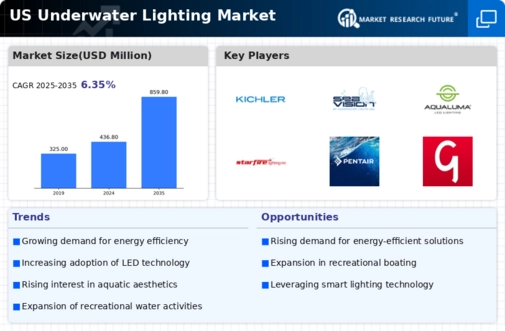The US Underwater Lighting Market has seen significant developments shaped by various market drivers. An increasing interest in aquatic recreation, including swimming pools, spas, and lakes, has driven homeowners and businesses to invest in effective underwater lighting solutions. The growing trend towards energy efficiency has also influenced the market, with consumers leaning towards LED lighting, as they not only offer better illumination but also reduce energy costs. Furthermore, advancements in technology have made smart underwater lighting systems more accessible, allowing users to control lights remotely, enhancing safety, and creating ambiance.
Opportunities to be explored within this market are abundant, especially with the growing focus on aesthetic appeal and custom lighting solutions. As the design of residential and commercial aquatic environments evolves, there is a rising demand for personalized underwater lighting options that can create unique visual effects. This trend aligns with the general consumer shift towards enhanced outdoor living spaces, spurred by the desire for relaxation and entertainment at home.
Moreover, as the US government emphasizes environmental sustainability, there is potential for manufacturers to develop eco-friendly underwater lighting options that not only meet regulatory standards but also cater to the environmentally conscious consumer. Recently, trends in the US market indicate a robust demand for versatile underwater lighting solutions that can withstand harsh conditions and extreme temperatures, especially in regions with variable climates. With water bodies across the US, from coastal areas to inland lakes, the need for durable and reliable lighting has become evident.
Additionally, the popularity of underwater lighting in landscape design has risen, as homeowners are increasingly using these fixtures to enhance the visual appeal of outdoor spaces, creating serene and inviting atmospheres. Hence, the US Underwater Lighting Market continues to adapt and evolve, reflecting the changing preferences of consumers and the influence of technology in design and functionality.
Source: Primary Research, Secondary Research, MRFR Database and Analyst Review
















Leave a Comment